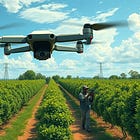Digital Fields, Smarter Yields: How Big Data is Redefining Modern Farming
From drones to smart apps, discover how accessible digital tools and data are levelling the agricultural playing field for farmers of all sizes.
"The data itself is not meaningful – the strength of data lies in converting it into knowledge." - Dr Ida Wilson
The Data-Driven Transformation of Agriculture
Agriculture has always evolved through innovation; from hand-tools to tractors. And now, from instinct to insight.
At the heart of today’s transformation is data (lots of it) and the digital technologies that help make sense of it. We are in the age of smart agriculture, and the change is not just deep, but broad.
Big data, once the realm of large enterprises, is now empowering smallholder farmers, family-run orchards, and independent producers with unprecedented precision.
Drones, smart sensors, mobile apps, and cloud platforms are no longer fringe tools. They’re the new standard. And crucially? They’re accessible.
Drones, Dashboards and the Democratisation of Data
Let’s begin in the sky: Drone-based aerial surveys are becoming the go-to method for collecting high-resolution imagery and multispectral data in real-time.
Whether it's Normalised Difference Vegetation Index (NDVI) for plant health, canopy volume tracking, or tree-by-tree stress detection, these technologies are generating the kind of insight that used to take weeks (if not an entire season) to gather.
Smart apps then step in to visualise this data. Cloud-based platforms translate raw inputs into user-friendly maps, alerts, and crop forecasts. These tools empower decisions that are timely, precise, and repeatable.
For example, in grain farming, precision practices like variable rate application (VRA) rely on this flow of spatial data. Farmers can now map the chlorophyll content of wheat or soya, pinpoint nutrient deficiencies, or track yield variability across a single field. The payoff? Less waste, more productivity, and healthier soil.
Perennial tree crops, berries, and vines? The payoffs are even bigger, as calculated data-driven interventions have knock-on effects on plant health and yield that can span seasons.
The Network Effect: When Data Talks to Data
A major benefit of digital farming is the possibility of interoperability.
Sensors talk to apps. Drones link with weather stations. Yield maps integrate with planting data. And it all adds up – not just in insight, but in value. As more tools connect, the whole ecosystem becomes smarter.
This is the power of network effects in agriculture. Each additional data stream (ie. soil moisture, temperature, plant health) improves the value of the rest. It’s no longer one dataset in isolation, but a collaborative, dynamic view of your operation.
For farmers, that means fewer blind spots. And faster decisions.
Marginal Costs of Replication (and a Netflix analogy)
What makes digital tools so transformative isn’t just their capability. It’s how infinitely replicable they are.
Unlike traditional farming inputs (water, fertiliser, fuel), digital solutions follow the logic of software. Once built, the cost to deliver one more user access – whether a multinational citrus conglomerate, or a smallholder in Free State – is effectively zero.
Think about Netflix. Every user pays roughly the same monthly fee, regardless of geography, status, or usage. Yet everyone has access to the same value, the same movies and shows irrespective of class, race, ethnicity, or status.
Digital agriculture works the same way. Whether you manage 2 hectares or 2,000, the same drone scan or yield monitoring app can guide your decisions. We all get value out.
This dramatically lowers the barrier to entry in terms of value gained from technology use; providing never seen before accessibility to high-end data results.
No longer is data-driven farming reserved for those with deep pockets. It’s now available in many cases via a smartphone alone.
Network Effects and the Power of Connection
Putting the last two sections above together (network effects and the power of digitial to be a great leveller in agriculture) we can look into how the value of a network grows faster than most people think.
Metcalfe’s Law - one of my favourites (and originally used to describe the growth of telecom and digital networks) says “the value of a network is proportional to the square of the number of connected participants.”
In other words, every time a new farmer, agronomist, or supply chain partner joins a network, the potential connections and information flows don’t just add up; they multiply. This value multiplication is passed on to all network participants.
That’s why trusted farming networks, co-operatives, and even well-run WhatsApp groups can become so powerful. When one farmer trials a new technique or tool, their results and experience ripple across the network, accelerating adoption (and data availability) for everyone else.
It’s also why platforms that connect farmers and data, and not just technology providers, can deliver an outsized impact.
In the right network, knowledge compounds. And the sooner you’re plugged in, the faster you benefit from it.
More Than Maps: The Value of Visualisation
Data isn’t useful until it becomes actionable. That’s why visualisation (maps, dashboards, alerts) is central.
Modern farm management systems allow you to overlay yield maps, sensor data, weather forecasts, and spray records, all in one place.
As Dr Ida Wilson put it: “The data itself is not meaningful – the strength of data lies in converting it into knowledge.”
The best systems do this automatically, using AI to detect trends, flag anomalies, and even recommend interventions.
Whether it’s pre-empting pest outbreaks, actioning biological controls, or optimising nutrient applications; we have the tools to guide real-world action.
From Insight to Action
The future of agriculture isn’t about replacing humans with algorithms. It’s about equipping humans with better information.
With the right data at their fingertips, farmers can farm smarter; saving water, protecting the environment, and improving yields.
"In agriculture, data is the new fertiliser - invisible, but essential to grow smarter, more sustainable farms."
– Dr Onai Mtengwa
Whether you're flying a drone, setting up weather sensors, or reviewing a dashboard on your phone… you’re part of a movement. One that blends biology with bytes, instinct with evidence.
This is the digital transformation of agriculture. And it’s not on the horizon. It’s already here.
💡 Try this AI Prompt:
“Evaluate whether adopting digital agriculture tools such as [drones, smart sensors, or precision apps] would benefit my operation. Consider my crop type of [list crop type/s], my location in [location], and climate, [current challenges], budget of [XYZ], and available labour of [X people]. Also provide the potential ROI, key risks, and a step-by-step low-risk adoption plan tailored to my situation. Prompt me to provide more information as needed.”
Replace the [bracketed details] with your own operation’s specifics, for the most useful and tailored response.









